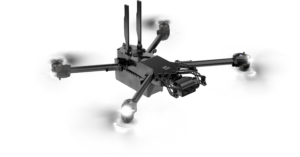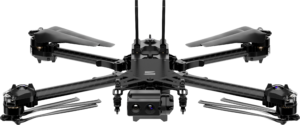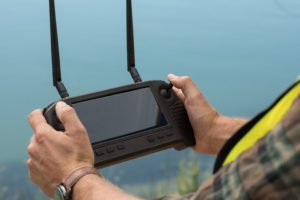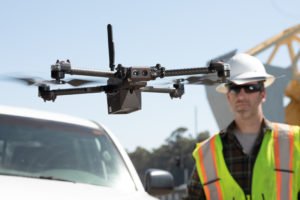Skydio, the Redwood City, CA startup, is flying high. Skydio’s X2 drones were announced today, along with an $100 million in Series C funding – which follows a $4 million investment that the U.S. Department of Defense announced this weekend.
$100 million may be the largest funding round the drone industry has seen so far – certainly one of the largest that has hit headlines since PrecisionHawk scored $75 million in 2018. Drone investments broke records in 2019, but the investment environment has shifted. While the hype cycle is over, investors are certainly still willing to put money into new technology with new capabilities and a market need.
$100 million is big news in any sector, but Skydio CEO Adam Bry is much more interested in the second part of Skydio’s big announcement: new product. “The funding is a nice validation of where we are as a company, but we put the most weight on the product and the customers,” says Bry. “The real success is the growth in customers that we’ve seen, and new capabilities.”
The new funding, Bry says, will go towards building out the company to serve those customers. “As a company, for the last 6 years, we’ve been very focused on core technology development,” says Bry. “That’s gotten us to where we are. Now, we’re expanding into sales, marketing, customer success… but we’re still very product driven.”
In addition to building out company functions, Skydio is increasing their production capability to keep up with demand. Skydio had to temporarily stop delivery of Skydio 2 at the start of California’s stay at home order during the current COVID-19 crisis. Since then, however, the Redwood, CA production facility has been re-opened for production. “I’m happy to say that we’re back to building and shipping drones – and we’re accelerating manufacturing quite a bit,” says Bry.
That the market is ready and waiting for Skydio drones is evident. More than 11% of public safety agencies report purchasing Skydio drones in the 9 months that they’ve become available: a huge number given the more than 90% dominance that DJI has held in the sector and the COVID-19 challenges that those 9 months have held. Forbes reports that government agencies are investing in Skydio too, including a $3 million contract with the U.S. Army and a $1.5 million contract with the U.S. Air Force. Those contracts represent a stunning success – in a stunningly short period of time.
 That success is because Skydio addresses a critical barrier to widespread adoption of drone technology: flying a manual drone well can be tricky. Flying a Skydio drone, accurately and safely, is easy. “This is the core thesis of the company since we started,” says Bry. “Being able to trust drones to fly themselves is a foundational layer.”
That success is because Skydio addresses a critical barrier to widespread adoption of drone technology: flying a manual drone well can be tricky. Flying a Skydio drone, accurately and safely, is easy. “This is the core thesis of the company since we started,” says Bry. “Being able to trust drones to fly themselves is a foundational layer.”
Nobody, says Bry, wants to crash their drone, risking safety issues and equipment damage. “My view on the industry is that we’re still very early days. The most enthusiastic businesses are training themselves to become expert pilots, because the value is there – but autonomy is foundational to getting broader acceptance.”
Skydio is a U.S.-based company, which may be helpful in getting government contracts at this moment in time, but it isn’t the primary selling point. “Consumers are generally happy to just buy the best product,” Bry says.
“From about 2015 to 2018, people assumed that there wasn’t going to be a U.S. company in the space – that U.S. companies just couldn’t compete in manufacturing,” he says. “I used to love to hear that – it created a vacuum of opportunity for us to operate in.”
Now, however, Bry expects that there will be more U.S.-based drone companies in the near future- simply because of the way that the technology is evolving. “What we see over time is that software becomes more and more important to these hardware components,” Bry points out. “That’s where the U.S. can really compete and innovate. ”
Skydio’s X2 Drones for the Enterprise
 Skydio Autonomy, described in the X2 press release as “the AI-powered brain built into every Skydio drone,” represents a significant innovation in the drone space. “Skydio Autonomy enables Skydio drones to fly themselves with the skills of an expert pilot,” says Skydio’s new product announcement. “It can also serve as an expert copilot, turning anyone into a skilled operator, while Skydio Autonomy dynamically controls the drone’s navigation to avoid obstacles even in GPS-denied environments.”
Skydio Autonomy, described in the X2 press release as “the AI-powered brain built into every Skydio drone,” represents a significant innovation in the drone space. “Skydio Autonomy enables Skydio drones to fly themselves with the skills of an expert pilot,” says Skydio’s new product announcement. “It can also serve as an expert copilot, turning anyone into a skilled operator, while Skydio Autonomy dynamically controls the drone’s navigation to avoid obstacles even in GPS-denied environments.”
As enterprise programs look for ways to improve the productivity of the staff they already have, rather than hire a fleet of pilots, this is an important difference. While companies still need to comply with FAA regulations, their pilots don’t necessarily need the same level of practice and training to get usable data for their jobs – and they can use drones as simply another tool in their bag. Enabling the existing workforce to fly is a far more efficient way of utilizing drones in an enterprise workflow than scheduling drone pilots across an organization: and Bry says that it’s the key to finally scaling drone programs in the enterprise.
 “Our autonomy technology enables a breakthrough flight experience and can be extended with specialized software skills to perform end to end automation of complex workflows,” says the Skydio release. Those “specialized software skills,” combined with a ruggedized airframe and powerful sensors, are designed to meet the needs of a broader range of enterprise and government customers.
“Our autonomy technology enables a breakthrough flight experience and can be extended with specialized software skills to perform end to end automation of complex workflows,” says the Skydio release. Those “specialized software skills,” combined with a ruggedized airframe and powerful sensors, are designed to meet the needs of a broader range of enterprise and government customers.
Skydio’s X2 Drones Family: X2D for the Military, X2E for Civilians.
Skydio X2 is a new series of products. The X2 acknowledges the military market with the Skydio X2D; the Skydio X2E provides the same level of data security, weather resistance, and autonomy but provides the right software and features for civilian and enterprise applications like inspections.
Government work has been a significant share of Skydio’s success so far, but Bry sees drones as a general hardware tool, which software and sensors may make more appropriate for a specific use. “In my view, what’s happened in the last 5 years is that people realize that these consumer heritage drones are really powerful tools,” says Bry. “To their credit, the DoD [U.S. Department of Defense] is recognizing this trend and buying into it. That’s something that we’re excited and proud to be a part of.”
“When engaging in these kind of things you want to be responsible and thoughtful about how you engage – but we feel like drones have the potential to do a lot of good,” says Bry. (Bry has published a blog post on responsible use principles: you can read it here.)
“The core differences between the X2 and the Skydio 2 is that X2 is built for the enterprise – it’s Skydio 2’s bigger brother. It’s a little bigger, it carries a thermal camera, it has a new radio system,” says Bry. “We’re constantly working with customers on their needs and their use cases – we saw a pretty strong convergence of requirements between all of our customers, government and civilian, and that’s what drove development of this product.”
Product Features
From the X2 product release:
…breakthrough autonomy software with a ruggedized airframe with folding arms for easy “pack and go” transportation, a thermal camera, and up to 35 minutes of flight time. X2 is equipped with six 4k navigation cameras for 360-degree obstacle avoidance and a dual sensor payload that includes 12MP color and 320×256 LWIR sensors. Designed, assembled, and supported in the USA, the X2 turns anyone into an expert pilot. It will initially be available in two configurations:
- Skydio X2D, built to meet the Short-Range Reconnaissance (SRR) requirements for the U.S. Army, the X2D is the ultimate solution for military and defense to perform reconnaissance, search and rescue, and security patrol missions.
- Skydio X2E, optimized for enterprises, first responders, and civilian agencies, the X2E is the ideal solution for situational awareness and inspection of infrastructure such as buildings, bridges, power plants, power stations and railyards. Skydio’s autonomous navigation technology makes it safe to fly at close distance to capture more accurate data than traditional manual drones.
Like Skydio 2, X2 drones include the Skydio Autonomy Core, Skydio’s world-leading flight AI engine. Out-of-the-box, X2 users will benefit from autonomous navigation with 360-degree, real-time obstacle avoidance, object detection and motion prediction.
The X2 products will be available in Q4 2020.
Skydio Autonomy Enterprise Foundation includes three new features that assist pilots in a wide variety of situations:
- 360 Superzoom for maximum situational awareness at 360 degrees. Superzoom blends the drone’s seven on-board cameras to let the pilot see in all directions while flying, and provides up to 100x digital zoom with high quality video resolution and electronic image stabilization.
- Precision Mode for maximum control while performing detailed inspections or getting tactical situational awareness in dense, challenging, GPS-denied environments. Skydio’s autonomy engine can be tuned to enable high precision response to controller inputs and to safely fly in close proximity to obstacles (.5 meters). These controls allow operators to fly confidently in tight spaces and to get the job done faster.
- Vertical View to capture images by looking straight up overhead. Combined with Skydio Autonomy’s Obstacle Avoidance technologies, allows users to focus on overhead inspection targets, instead of dedicating their inspection camera to avoiding obstacles.
In addition to these capabilities, Skydio’s new software – available for both Skydio 2 and Skydio X2 – targets inspection applications, both for industrial and residential properties. Skydio 3D Scan for autonomous inspection of industrial structures is a solution designed for complex structures and locations. Beneficial for bridge or energy infrastructure inspections, 3D Scan could also provide significant benefit for public safety agencies working on accident and crime scenes. Skydio 3D Scan will be available for both S2 and X2 in Q4 2020.
Skydio House Scan is designed for inspection of residential properties, and here Skydio has made some smart partnerships. Skydio House Scan is delivered in partnership with Eagleview, a leading provider of aerial imagery, data analytics and geographic information system solutions. “Skydio House Scan enables home insurance agents to automatically perform accurate inspection of residential homes safely and without the need to become expert drone pilots,” says the product release.
Skydio House Scan will be available in Q4 2020.
Miriam McNabb is the Editor-in-Chief of DRONELIFE and CEO of JobForDrones, a professional drone services marketplace, and a fascinated observer of the emerging drone industry and the regulatory environment for drones. Miriam has penned over 3,000 articles focused on the commercial drone space and is an international speaker and recognized figure in the industry. Miriam has a degree from the University of Chicago and over 20 years of experience in high tech sales and marketing for new technologies.
For drone industry consulting or writing, Email Miriam.
TWITTER:@spaldingbarker
Subscribe to DroneLife here.
https://dronelife.com/2020/07/13/skydios-x2-drones-ceo-adam-bry-talks-breakthrough-autonomy-and-100-million/
 Unmanned Aerial Vehicle The latest drone news
Unmanned Aerial Vehicle The latest drone news




